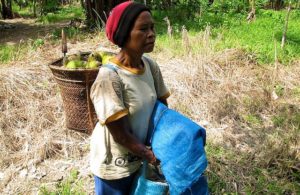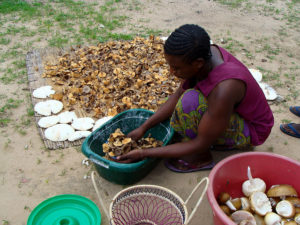
By Jack Hewson, originally published at CIFOR’s Forests News
New research by the Center for International Forestry Research (CIFOR) shows that forests play an important role in the diets of many households and communities living in close proximity to tropical forests.
The findings contribute to a growing body of evidence that suggests deforestation and forest conversion to crops pose a threat to communities that receive their nutritional requirements from forests.
The study, led by Ph.D. scholar Dominic Rowland, is the first to use standardized survey methods across multiple different sites to quantify the consumption of forest foods and compare them with dietary guidelines. The research team examined wild forest food consumption in smallholder-dominated forests in 37 sites across 24 tropical countries.
According to Rowland, even though there have been many studies looking at the links between forest food and nutrition, there has not yet been an application of uniform criteria to provide a globally comparative perspective.
“As far as we’re aware, this is the first of its kind,” he says. “We tested the hypothesis that the consumption of forest foods can make important contributions to dietary quality in a wide range of sites across the tropics.”
Drawing on data collected by the Poverty and Environment Network (PEN) — a collaborative research project led by CIFOR — the research team was able to estimate the contributions of forest foods to nutrition by comparing intake with various dietary recommendations and average consumption patterns.
“There are all kinds of foods that come from the forest, including anything from land snails to wild fruits and primates,” Rowland says. “We focused on nutritionally important food groups that are often lacking in the average diets in these countries. For these food groups, primarily it is bushmeat, fish and fruit for which the forest is relied upon, as well as vegetables.”
According to Rowland, the study likely underestimates the quantities of forest foods consumed, as it only analyzes the consumption of those foods that were collected by households, and does not include foods collected for trade purposes, or those given as gifts and bartered — practices that are common in many forest communities.

VARYING RESULTS
While the dietary contribution of forest foods to nutritional requirements at many survey sites was substantial, results varied significantly.
The top quartile of forest food users at some sites obtained as much as 106 percent of their requirements for meat and fish from the forest. But for other communities, the contribution was negligible.
Due to the global scope of the study, it is perhaps unsurprising that a large variety of forest food consumption patterns were identified, with very few uniformities. However, Rowland and his fellow researchers created rough categories to simplify their findings, which included communities that are “forest-food dependent” on one hand, and those that have “limited forest use” on the other.
“You can’t say that forest foods are universally important. But you also can’t say that forest foods don’t make much difference to diets. There are no overarching generalizations to be made, as it really depends on the local context.”
Another recent CIFOR study focusing on forests and diets in Indonesia also found substantial differences across regions.
LAND USE CHANGE IMPACTS ON DIET
However, in areas where there is a heavy reliance on the forest for nutrition, deforestation or wholesale conversion to crops can harm the diets of local people.
“The scale and importance of wild food use must be taken into account when making landscape-scale land-use decisions,” Rowland says.
According to research conducted by the Food and Agriculture Organization, it is often the poorest who are most reliant on forests for food. Those who live near the poverty line may be subject to food insecurity in times of food shortage, famine, or when stocks from the previous season are exhausted. For these people, forests provide a crucial safety net.
Landscapes that are converted from mixed crops to monoculture may also become at risk of food insecurity, leaving residents unable to receive proper nutrition.
For example, another study conducted by CIFOR in south Cameroon highlighted concerns that wholesale conversion of land to palm oil was threatening local food security. While some smallholder producers of palm oil welcomed the conversion to the high-yield crop, others residents were unable to profit from it, and with limited income, found it difficult to access food.
“Our findings suggest that deforestation and land-use change may have unforeseen consequences on the quality of local people’s diets,” Rowland says.
“I think the policy implications are that when decisions are made about agriculture, you need to take into account the impact on local people’s diets because monoculture might not provide people with sources of nourishing food.
“Research like this increasingly underscores the validity of the ‘landscape approach’ — which champions the establishing of mixed-use landscapes.”











